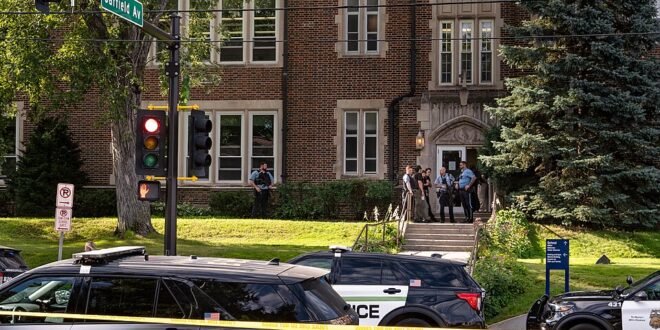The recent events surrounding the Minneapolis shooting have sent ripples of concern and sorrow throughout the community and beyond. When such incidents occur, they inevitably spark a deep dive into the underlying factors, the immediate responses, and the long-term implications for public safety and mental health. This particular incident, involving an active shooter at Annunciation Catholic School in Minneapolis, quickly garnered national attention, raising critical questions about gun violence, school security, and the well-being of those affected. The swift actions of law enforcement and emergency services were crucial in managing the immediate crisis, but the aftermath leaves many grappling with complex emotions and seeking answers. The incident underscores the pervasive nature of gun violence in modern society and the urgent need for comprehensive solutions that address both its symptoms and root causes. It’s a stark reminder of how quickly peace can be shattered, transforming ordinary days into moments of profound grief and collective introspection for residents.
Details emerging from the scene painted a picture of a community in shock. The Minneapolis police department, along with other agencies, responded with commendable speed, securing the area and ensuring the safety of students and staff. Initial reports and eyewitness accounts provided a fragmented but urgent narrative that eventually coalesced into a clearer understanding of what transpired. The incident also brought to the forefront the challenges faced by first responders and the immense pressure they operate under during active threat scenarios. The immediate aftermath involved not only securing the building but also providing trauma support to those who witnessed or were directly impacted by the events. The rapid dissemination of information, while vital, also contributed to a sense of heightened anxiety, as people sought to understand the full scope of the tragedy and its implications for their loved ones and community. This collective experience highlights the critical role of accurate and timely communication during crises.
The names associated with the shooting, such as Robin Westman and Fletcher Merkel, quickly became central to the unfolding narrative, as investigators worked to piece together the motives and circumstances surrounding the incident. The concept of a “manifesto” often arises in such cases, hinting at deeper, often disturbed, motivations. In the context of the Annunciation Catholic School shooting, understanding the perpetrator’s background and intentions becomes a crucial, albeit painful, part of the investigative process. These details are not merely for forensic purposes; they help the community and authorities grasp the complexity of such acts and inform future prevention strategies. The focus extends beyond the immediate act to the life stories, mental states, and societal factors that might contribute to such extreme violence. The search for a “why” is an inherent human response to tragedy, driving efforts to prevent similar occurrences in the future. This aspect of the investigation often leads to broader discussions about mental health resources and societal support systems.
The Minneapolis shooting at Annunciation Catholic School has left an indelible mark on the local community, extending far beyond the immediate vicinity of the incident. Schools, places of worship, and neighborhoods grapple with increased anxiety and a renewed focus on security measures. The discussion around “why are flags at half mast today” often becomes a poignant symbol of collective mourning and remembrance, signifying a community in shared grief. This particular tragedy highlights the unique vulnerability of schools and churches, places traditionally considered safe havens. Parents, students, and educators are left to confront difficult questions about safety protocols, mental health support, and the pervasive fear of violence. The long-term psychological impact on those directly involved, as well as on the broader community, cannot be overstated. Support groups, counseling services, and community forums become essential resources in the healing process, underscoring the need for sustained and compassionate responses to such traumatic events.
The role of local news outlets like KARE 11, WCCO, and the Star Tribune has been crucial in keeping the public informed, providing updates on the investigation, and sharing stories of resilience within the community. These media platforms become vital conduits for information, offering both factual reporting and a space for community reflection. Beyond factual reporting, they often delve into the human stories behind the headlines, providing a more empathetic understanding of the tragedy’s impact. Their coverage helps to contextualize the event, offering insights into the ongoing efforts of law enforcement and the collective response of Minneapolis residents. The careful balance between informing the public and avoiding sensationalism is a constant challenge for journalists during such sensitive times, as they strive to provide accurate news while respecting the pain of those affected. The local media’s sustained engagement helps maintain public awareness and encourages community involvement in recovery efforts.
The broader conversation around school shootings in 2025, and indeed school shootings in general, has been reignited with urgency. This incident adds to a growing and grim statistic, prompting renewed calls for comprehensive gun control measures, enhanced mental health services, and improved school security. The debate surrounding these issues is often polarized, but incidents like the Minneapolis shooting underscore the shared desire for safer communities and schools. Policy discussions at local, state, and national levels often intensify after such events, with lawmakers and advocates pushing for legislative changes that address gun violence and mental health care. Comparing this incident to past tragedies, such as Columbine, highlights both the recurring patterns of violence and the evolving strategies for prevention and response. The collective responsibility to protect children and create secure learning environments becomes a paramount concern for everyone. The data table below provides a snapshot of relevant information surrounding the incident.
The response to the Minneapolis shooting extended quickly from local emergency services to statements from state and national figures. The Mayor of Minneapolis, Jacob Frey, and the Governor of Minnesota often play critical roles in addressing the public, offering condolences, and outlining steps for recovery and prevention. These leaders become vital voices in times of crisis, helping to unite the community and guide collective action. Their messages often emphasize resilience, unity, and a commitment to ensuring safety and justice. Senator Amy Klobuchar, a prominent Minnesota politician, also typically weighs in on such events, highlighting the need for federal action and support. The White House live streams and press conferences sometimes address such incidents, signaling the national significance and the broader implications for public policy on gun violence. These statements, delivered from various levels of government, underscore the far-reaching impact of such tragedies and the collective effort required to address them. The coordination among different levels of government is crucial in providing a unified and effective response.
The discussion surrounding figures like “Robert Westman” or “Robin Westman” (given the variations in reporting) often includes examining their background, potential motives, and any “manifesto” they might have left behind. Understanding the perpetrator is a critical part of the post-incident analysis, as it can offer insights into the warning signs and preventive measures that could be implemented in the future. The investigative process aims to construct a complete picture of the events, from the initial planning to the execution of the act. This can involve extensive forensic work, interviews, and the analysis of digital footprints. While it’s important not to glorify the perpetrators, understanding their pathways to violence is essential for developing effective intervention strategies. The focus remains on learning from these tragic events to prevent future harm, rather than simply assigning blame. This detailed examination helps identify systemic failures and areas for improvement in social and mental health support systems.
The tragic events at Annunciation Catholic School also prompt a closer look at existing gun laws in Minnesota and potential avenues for reform. The debate often centers on balancing Second Amendment rights with the imperative to reduce gun violence, especially in vulnerable settings like schools. Advocates for stricter gun control often point to the frequency of mass shootings and school shootings as evidence of the need for change, while others emphasize mental health interventions and enhanced security measures. The legislative landscape around gun control is complex and highly contentious, with various stakeholders proposing different solutions. The incident in Minneapolis inevitably fuels this ongoing national conversation, with calls for universal background checks, red flag laws, and other regulatory measures gaining renewed traction. The dialogue extends to how communities can better protect themselves, exploring both legislative and community-based solutions to enhance safety. This ongoing debate reflects the deep societal divisions and the urgent need for common ground to address gun violence effectively.
The aftermath of the Minneapolis shooting involves a multifaceted approach to healing and recovery for the entire community. This includes providing immediate mental health support for students, teachers, and families, as well as establishing long-term counseling services. Schools often implement specific programs to help children process trauma and feel safe returning to their learning environment. Community vigils, memorial services, and fundraising efforts, often supported by platforms like GoFundMe, play a vital role in collective grieving and providing tangible support to victims and their families. These acts of solidarity demonstrate the resilience of the community and its commitment to healing together. The focus shifts from the immediate crisis to sustained efforts that address the emotional, psychological, and practical needs of those affected. The ongoing support ensures that no one is left to cope with the trauma alone, fostering a sense of shared responsibility and compassion. Establishing clear lines of communication and support ensures a comprehensive recovery process.
Security enhancements at schools and churches are another significant outcome of such incidents. This can range from increased police presence and improved surveillance systems to specialized training for staff on active shooter protocols. The debate often includes discussions about armed guards, secure entryways, and sophisticated alert systems designed to minimize risk during critical incidents. While these measures can provide a sense of security, they also raise questions about the balance between safety and creating an overly militarized environment in educational settings. The goal is to create environments where students and congregants can feel safe and focus on learning and worship without the constant threat of violence. Evaluating and updating security protocols becomes an ongoing process, informed by best practices and lessons learned from past tragedies. The implementation of robust security measures is a direct response to the heightened sense of vulnerability experienced by these institutions.
The media’s role in the aftermath is equally critical, balancing the need to inform with the responsibility to avoid re-traumatizing the community. News organizations like Fox 9 News and MPR News continue to follow the story, providing updates on the investigation, legal proceedings, and the long-term impact on individuals and institutions. Their reporting helps to keep the issue in the public consciousness, fostering ongoing dialogue and advocacy for change. The media also plays a crucial role in highlighting stories of heroism, resilience, and community support, which can be vital for the healing process. However, the media’s portrayal also shapes public perception, making accurate and sensitive reporting paramount. The continuous coverage helps to ensure that the memory of the victims is honored and that the lessons learned from the tragedy are not forgotten, driving continued efforts toward prevention and recovery. Responsible journalism contributes significantly to the community’s ability to heal and move forward.
Community engagement is a cornerstone of preventing future tragedies like the Minneapolis shooting. This involves fostering open dialogues about mental health, encouraging reporting of suspicious behavior, and creating supportive networks that can identify and help individuals in distress. Programs aimed at promoting empathy, conflict resolution, and anti-bullying initiatives within schools and communities can play a significant role in fostering a culture of peace. The involvement of local leaders, religious organizations, and mental health professionals is crucial in building resilient communities that are equipped to address the complex factors contributing to violence. These grassroots efforts complement broader policy changes, creating a holistic approach to public safety. Empowering community members to be active participants in prevention efforts instills a sense of collective responsibility and fosters a more secure environment for everyone. Collaborative initiatives help strengthen social bonds and address underlying issues before they escalate.
Preventative measures extend beyond immediate security to encompass early intervention strategies for individuals exhibiting warning signs of violence. This includes improving access to mental health services, reducing stigma around mental illness, and providing resources for families struggling to support loved ones with behavioral challenges. The concept of “red flag laws,” which allow temporary removal of firearms from individuals deemed a danger to themselves or others, is often discussed as a key preventative tool. These measures aim to intervene before a crisis escalates, offering support and preventing harm. The challenge lies in balancing individual rights with the need for public safety, a complex ethical and legal landscape that requires careful consideration. Developing effective early warning systems and accessible support networks is vital in identifying and assisting at-risk individuals before they resort to violence. Proactive interventions are essential for breaking the cycle of violence and promoting well-being.
The long-term success of prevention efforts hinges on sustained investment in community resources and ongoing education. This means not only allocating funds for mental health and social services but also fostering a culture of awareness and vigilance. Training programs for recognizing potential threats, knowing how to respond during an active shooter event, and understanding the importance of reporting concerns are all vital components. The aim is to create a community that is informed, prepared, and proactive in addressing potential risks. This holistic approach, combining legislative action, mental health support, security enhancements, and community engagement, represents the most comprehensive strategy for preventing future tragedies. The continuous evolution of these strategies, informed by research and community feedback, is essential for adapting to new challenges and ensuring the safety and well-being of all residents. A robust and adaptable framework is necessary for long-term success.
Victims and Survivors
At the heart of any shooting incident are the victims and survivors, whose lives are irrevocably altered by the trauma. The Minneapolis shooting victims, including figures like Jesse Merkel, Robin Westman, or any other individual directly harmed, become the focal point of collective sympathy and support. Their stories highlight the profound human cost of gun violence, moving beyond statistics to individual experiences of loss, pain, and resilience. The immediate aftermath involves critical care for the injured and compassionate support for the bereaved families. For survivors, the journey often includes extensive physical and psychological recovery, sometimes lasting a lifetime. The community rallies around these individuals, offering emotional, financial, and practical assistance to help them navigate the immense challenges they face. Recognizing and honoring their experiences is a crucial part of the healing process for the entire community. Their courage in the face of adversity serves as a powerful testament to the human spirit’s ability to endure and rebuild.
The emotional and psychological toll on survivors extends to witnesses and those indirectly affected, including students, teachers, and first responders. The trauma of witnessing such an event can manifest in various ways, from anxiety and depression to post-traumatic stress disorder (PTSD). Providing immediate and ongoing psychological support is critical for these individuals to process their experiences and prevent long-term mental health challenges. This often involves specialized counseling, support groups, and resources tailored to the specific needs of trauma survivors. The community’s response must encompass not only physical safety but also mental and emotional well-being, acknowledging that healing is a complex and often lengthy process. Creating safe spaces for individuals to share their experiences and feelings is an essential component of recovery, fostering a sense of solidarity and mutual understanding. This comprehensive support helps individuals reintegrate into their daily lives with greater resilience.
The stories of those who bravely responded during the crisis, whether law enforcement officers, school staff, or even fellow students, often emerge as powerful narratives of courage and selflessness. These acts of heroism, though born out of tragedy, serve as reminders of the human capacity for compassion and resilience in the face of extreme danger. Acknowledging and honoring these individuals helps to reinforce positive community values and provides examples of how individuals can make a difference during critical moments. The post-incident debriefings and psychological support provided to first responders are also vital, recognizing the significant emotional burden they carry. Their dedication to protecting others, often at great personal risk, underscores the importance of their training and the critical role they play in crisis management. These inspiring accounts of bravery contribute to the collective healing process, demonstrating the strength of the human spirit in adversity.
Future Outlook
Placing the Minneapolis shooting within a broader historical context of school shootings and mass violence reveals both recurring patterns and evolving challenges. From events like Columbine to more recent incidents, each tragedy adds to a grim tapestry of gun violence in America, prompting ongoing debates about its causes and potential solutions. Understanding this history is crucial for developing effective prevention strategies, as it allows us to analyze trends, identify common risk factors, and evaluate the effectiveness of past interventions. The ongoing nature of this problem highlights the urgent need for innovative approaches that address not only immediate threats but also the underlying societal issues that contribute to violence. Examining the progression of these events helps inform policy decisions and societal responses, encouraging a more proactive stance toward preventing future tragedies. This historical perspective reinforces the idea that gun violence is a complex, multifaceted issue requiring sustained attention and adaptive strategies.
The discussion often includes the role of mental health, socio-economic factors, and access to firearms as contributing elements to these tragic events. While there is no single cause, a holistic understanding of these interconnected factors is essential for developing comprehensive prevention strategies. The focus on mental health resources has intensified, with calls for better access to care, early intervention programs, and reduced stigma surrounding mental illness. Simultaneously, debates about gun laws continue, exploring the balance between individual rights and public safety. Addressing these complex issues requires a multi-pronged approach that involves government agencies, community organizations, mental health professionals, and engaged citizens working collaboratively. The future outlook for preventing such incidents depends on sustained commitment to these diverse strategies, fostering a society that prioritizes both safety and well-being. A nuanced understanding of these contributing factors is critical for implementing effective, long-term solutions.
Looking ahead, the Minneapolis shooting serves as a stark reminder of the continuous need for vigilance, compassion, and proactive measures to prevent gun violence. The commitment to learning from these tragedies, supporting victims and survivors, and implementing meaningful change is paramount. This includes advocating for sensible policies, investing in mental health infrastructure, and strengthening community bonds. The hope is that through collective action and a shared dedication to safety, communities like Minneapolis can emerge stronger and more resilient, fostering environments where such tragedies become increasingly rare. The path forward is challenging, but the resolve to protect future generations and create safer spaces remains a driving force for positive change. Continued engagement from all sectors of society is essential for building a future where gun violence is no longer a pervasive threat, transforming grief into renewed purpose. This ongoing dedication is key to creating lasting and impactful change.




